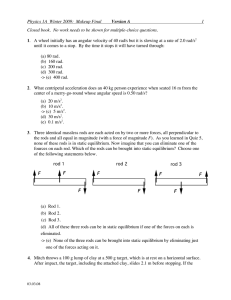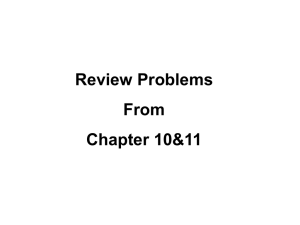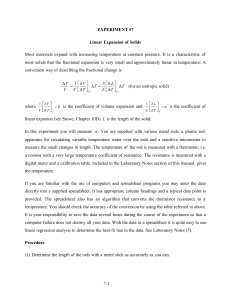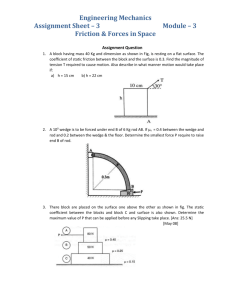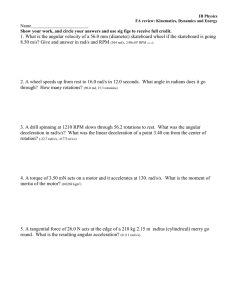At the top of the path, the angular speed is... point? Version A
advertisement
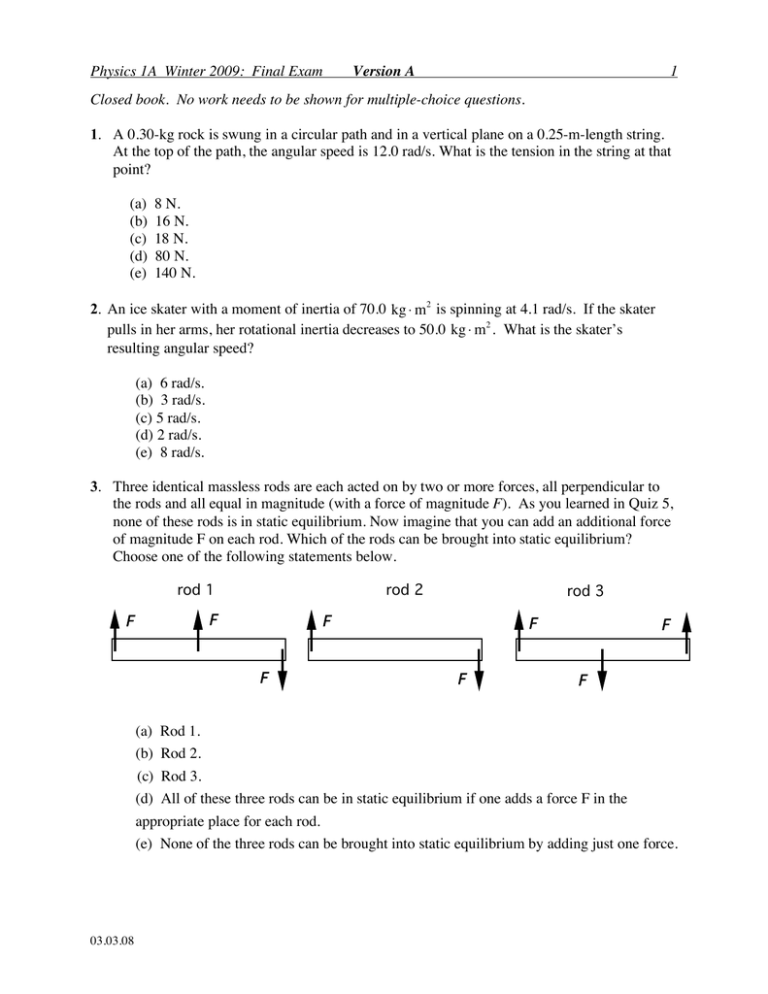
Physics 1A Winter 2009: Final Exam Version A 1 Closed book. No work needs to be shown for multiple-choice questions. 1. A 0.30-kg rock is swung in a circular path and in a vertical plane on a 0.25-m-length string. At the top of the path, the angular speed is 12.0 rad/s. What is the tension in the string at that point? (a) (b) (c) (d) (e) 8 N. 16 N. 18 N. 80 N. 140 N. 2. An ice skater with a moment of inertia of 70.0 kg ! m2 is spinning at 4.1 rad/s. If the skater pulls in her arms, her rotational inertia decreases to 50.0 kg ! m2 . What is the skater’s resulting angular speed? (a) 6 rad/s. (b) 3 rad/s. (c) 5 rad/s. (d) 2 rad/s. (e) 8 rad/s. 3. Three identical massless rods are each acted on by two or more forces, all perpendicular to the rods and all equal in magnitude (with a force of magnitude F). As you learned in Quiz 5, none of these rods is in static equilibrium. Now imagine that you can add an additional force of magnitude F on each rod. Which of the rods can be brought into static equilibrium? Choose one of the following statements below. rod 1 F rod 2 F rod 3 F F F F F F (a) Rod 1. (b) Rod 2. (c) Rod 3. (d) All of these three rods can be in static equilibrium if one adds a force F in the appropriate place for each rod. (e) None of the three rods can be brought into static equilibrium by adding just one force. 03.03.08 Physics 1A Winter 2009: Final Exam Version A 2 4. Blocks A and B are moving toward each other. Block A has a mass of 2.0 kg and a velocity of 50 m/s, while block B has a mass of 4.0 kg and a velocity of –25 m/s. The blocks stick together after the collision. The kinetic energy lost during the collision is: a. 0. b. 1250 J. c. 3750 J. d. 5000 J. e. 5600 J. 5. A woman weighing 730N stands in the middle of a frozen pond of radius 10m. She is unable to get to the other side because of a lack of friction between her shoes and the ice. To propel herself, she throws a 2.4kg backpack horizontally towards the south shore at a speed of 5m/s. How long does it take her to reach the north shore? a. b. c. d. e. 30s 60s 90s 120s 150s 6. A ball of mass 5.0 kg initially moves with a speed of 3.0 m/s in the +x direction and with a speed 3.0m/s in the +y direction. It then hits a wall defined by the coordinates x=0. (Hint: This defines a wall in the y-z plane) Assuming this is an elastic collision, what’s the change in momentum of the ball? a. (x,y,z) = – (30 kg(m/s), 0, 0). b. (x,y,z) = - (30 kg(m/s), 30 kg(m/s), 0). c. 0 kg(m/s). d. (x,y,z) = (30 kg(m/s), 0, 0). e. none of the above. 7. A Newton is a: a. kg m/s3 b. kg/s2 c. kg m/s d. kg m/s2 e. kg m2/s2 8. A 20-N crate starting at rest slides down a rough 5.0-m long ramp, inclined at 25° with the horizontal. 20 J of energy is lost to friction. What will be the speed of the crate at the bottom of the incline? a. 0.98 m/s b. 1.9 m/s c. 3.2 m/s d. 4.7 m/s e. 6.4 m/s 03.03.08 Physics 1A Winter 2009: Final Exam Version A 9. An outfielder throws a 0.150 kg baseball at a speed of 40.0 m/s at an initial angle of 30.0o with respect to the horizontal. What is the kinetic energy of the baseball at the highest point of its motion? a. zero b. 120 J c. 30.0 J d. 52.0 J e. 90.0 J 10. An incline forms a 55 degree angle with the vertical. A 3.0kg box is sitting on the incline with a coefficient of static friction of 0.30, and a coefficient of kinetic friction of 0.25. What minimum force must be applied to the crate perpendicular to the incline to prevent the box from sliding down the incline? a. b. c. d. e. 30N 31N 32N 33N 34N 11. Two blocks are in contact on a frictionless surface., sitting horizontally next to each other. You apply a force of 4.0N to block 1 such that it pushes against block two. Mass of block 1 = 3.0kg. Mass of block 2 = 1.2 kg. What is the magnitude of the force between the two blocks? a. b. c. d. e. 1N 2N 3N 4N 5N 12. A boat crosses a river with a velocity of 5.3km/h at an angle 62.5 degree north of west relative to the water. The river is 800m wide and carries an eastward current of 2km/h. How far upstream is the boat when it reaches the shore? a. b. c. d. e. 20m 40m 60m 80m 100m 13. A car drives North at 40miles/h for 10min, then turns East and goes 5.0 min at 60 miles/h. Finally, it goes Southwest at 30miles/h for 6.0 min. How far away is the car at the end from the place it started? (1st Hint: I'm asking for the distance "as the crow flies") (2nd Hint: Define a coordinate system, and use vector addition.) a. 10miles 03.03.08 3 Physics 1A Winter 2009: Final Exam b. c. d. e. Version A 4 20miles 30miles 40miles 5miles 14. A 2.0m tall basketball player is standing on the floor 10.0 m away from the basket. If she throws the ball at a 40 degree angle with the horizontal, at what initial speed must she throw the ball so that it goes through the hoop without striking the backboard? The height of the basket is 3.05 m. a. b. c. d. e. 2 m/s 4 m/s 6 m/s 8 m/s 10 m/s 15. A Cessna aircraft has a lift-off speed of 200km/h. This is the minimum speed it needs to lift off the ground. What minimum constant acceleration is required if the takeoff runway is only 250m long? a. 2.0 m/s2 b. 2.5 m/s2 c. 3.0 m/s2 d. 3.5 m/s2 e. 4.0 m/s2 16. How many logs of wood (density of wood = 0.73 g/cm3 ) are needed to float a 1000 kg car on water (density of water = 1000 kg/m3 ). A log of wood is 3m long and 25cm in diameter. a. 14 b. 17 c. 20 d. 23 e. 26 17. Water enters a house through a pipe with an inside diameter of 2cm at an absolute pressure P. The pipe narrows to a diameter of 1cm before it leads from the ground floor (where the water piping enters the house) to the second floor bathroom, 5m above. When the flow speed at the 2cm diameter inlet is 1.5m/s, the water pressure in the bathroom is 330kPa. What is the pressure, P, of the water as it enters the house? (density of water = 1000kg/m3 ) a. 340kPa b. 360kPa c. 380kPa d. 400 kPa e. 420kPa 03.03.08 Physics 1A Winter 2009: Final Exam Version A 5 18. Water at a pressure of 400 kPa is flowing at 1.5m/s through a pipe, when it encounters an obstruction where the pressure drops by 5%. What fraction of the pipe's area is obstructed? a. b. c. d. e. 40% 50% 60% 70% 80% 19. The water in a garden hose is at a gauge pressure of P, and is moving at negligible speed. The hose terminates in a sprinkler system consisting of many small holes. The maximum height reached by the water from the emerging holes is 15m. What is the gauge pressure P? a. 50,000 Pa b. 100,000 Pa c. 150,000 Pa d. 200,000 Pa e. 250,000 Pa 1) A 2) A 3) C 4) C 5) B 6) A 7) D 8) D 9) E 10) C 11) A 12) D 13) E 14) E 15) E 16) E 17) C 18) D 19) C 03.03.08
